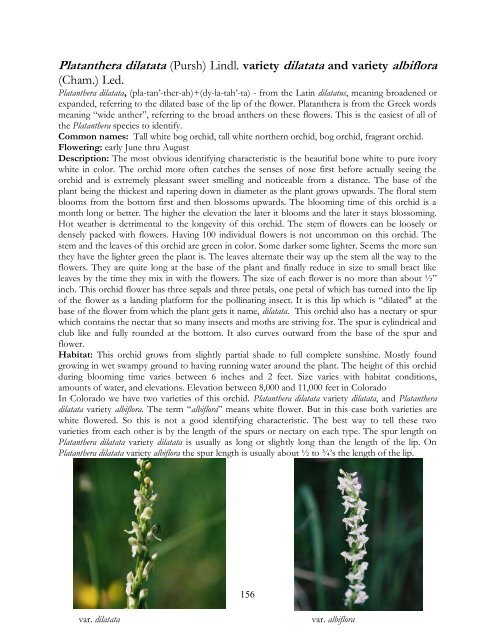Scotty Smith's Orchids of Colorado. - Southwest Colorado Wildflowers
Scotty Smith's Orchids of Colorado. - Southwest Colorado Wildflowers
Scotty Smith's Orchids of Colorado. - Southwest Colorado Wildflowers
You also want an ePaper? Increase the reach of your titles
YUMPU automatically turns print PDFs into web optimized ePapers that Google loves.
Platanthera dilatata (Pursh) Lindl. variety dilatata and variety albiflora(Cham.) Led.Platanthera dilatata, (pla-tan‟-ther-ah)+(dy-la-tah‟-ta) - from the Latin dilatatus, meaning broadened orexpanded, referring to the dilated base <strong>of</strong> the lip <strong>of</strong> the flower. Platanthera is from the Greek wordsmeaning “wide anther”, referring to the broad anthers on these flowers. This is the easiest <strong>of</strong> all <strong>of</strong>the Platanthera species to identify.Common names: Tall white bog orchid, tall white northern orchid, bog orchid, fragrant orchid.Flowering: early June thru AugustDescription: The most obvious identifying characteristic is the beautiful bone white to pure ivorywhite in color. The orchid more <strong>of</strong>ten catches the senses <strong>of</strong> nose first before actually seeing theorchid and is extremely pleasant sweet smelling and noticeable from a distance. The base <strong>of</strong> theplant being the thickest and tapering down in diameter as the plant grows upwards. The floral stemblooms from the bottom first and then blossoms upwards. The blooming time <strong>of</strong> this orchid is amonth long or better. The higher the elevation the later it blooms and the later it stays blossoming.Hot weather is detrimental to the longevity <strong>of</strong> this orchid. The stem <strong>of</strong> flowers can be loosely ordensely packed with flowers. Having 100 individual flowers is not uncommon on this orchid. Thestem and the leaves <strong>of</strong> this orchid are green in color. Some darker some lighter. Seems the more sunthey have the lighter green the plant is. The leaves alternate their way up the stem all the way to theflowers. They are quite long at the base <strong>of</strong> the plant and finally reduce in size to small bract likeleaves by the time they mix in with the flowers. The size <strong>of</strong> each flower is no more than about ½”inch. This orchid flower has three sepals and three petals, one petal <strong>of</strong> which has turned into the lip<strong>of</strong> the flower as a landing platform for the pollinating insect. It is this lip which is “dilated" at thebase <strong>of</strong> the flower from which the plant gets it name, dilatata. This orchid also has a nectary or spurwhich contains the nectar that so many insects and moths are striving for. The spur is cylindrical andclub like and fully rounded at the bottom. It also curves outward from the base <strong>of</strong> the spur andflower.Habitat: This orchid grows from slightly partial shade to full complete sunshine. Mostly foundgrowing in wet swampy ground to having running water around the plant. The height <strong>of</strong> this orchidduring blooming time varies between 6 inches and 2 feet. Size varies with habitat conditions,amounts <strong>of</strong> water, and elevations. Elevation between 8,000 and 11,000 feet in <strong>Colorado</strong>In <strong>Colorado</strong> we have two varieties <strong>of</strong> this orchid. Platanthera dilatata variety dilatata, and Platantheradilatata variety albiflora. The term “albiflora” means white flower. But in this case both varieties arewhite flowered. So this is not a good identifying characteristic. The best way to tell these twovarieties from each other is by the length <strong>of</strong> the spurs or nectary on each type. The spur length onPlatanthera dilatata variety dilatata is usually as long or slightly long than the length <strong>of</strong> the lip. OnPlatanthera dilatata variety albiflora the spur length is usually about ½ to ¾‟s the length <strong>of</strong> the lip.156var. dilatatavar. albiflora







